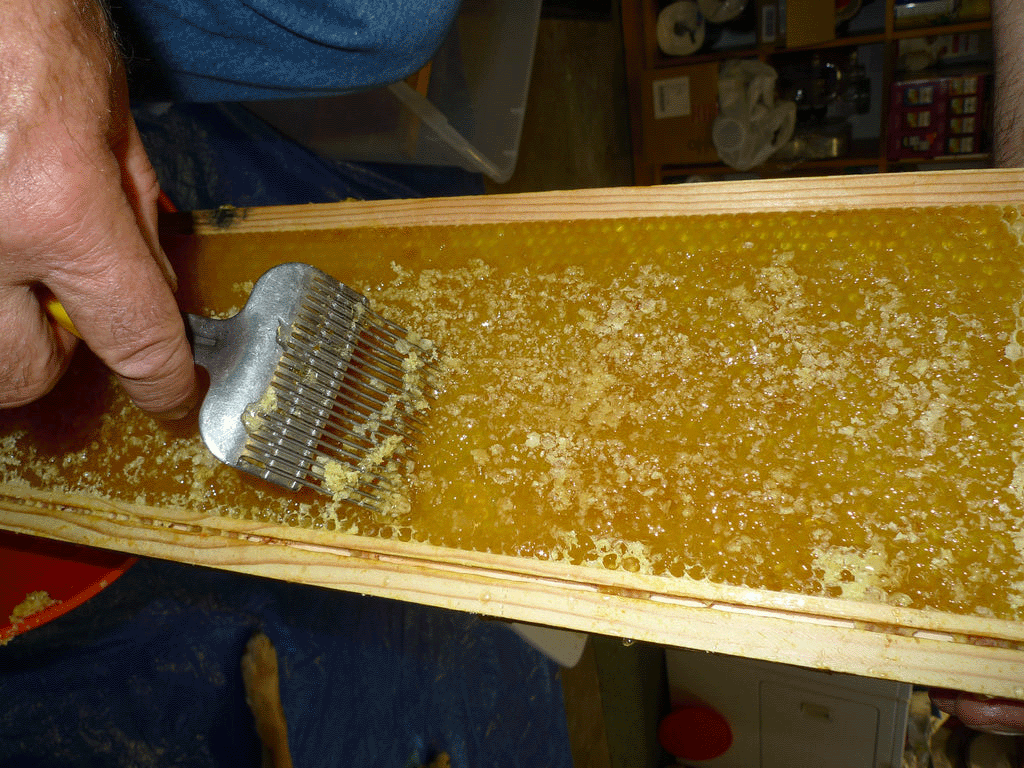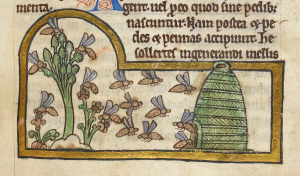by- Jim Thompson
It all depends on how you plan to use the Cappings Scratcher or the Uncapping Fork as to what you want to call it.
Originally this device was designed to scratch the low spots of the cappings that were missed by the uncapping knife or plane. A second use of the cappings scratcher was found as an inspection tool. One could insert the tines of the fork into drone brood and pull out the brood and look for the female Varroa mites on the white drone larva. The motion of scratching and pulling of only a few tines puts a lot of force on the tines and it is only a matter of time until the end tines are bent or pulled out of the plastic.
A third use for the fork is to uncap the honey cells. The entire width of the fork tines are inserted just below the cappings and pulled upward removing the beeswax. Just think, no heat required and only the cappings and a small amount of honey are removed. If you used a knife you take more honey and wax because you are straightening out the comb using the frame as a guide. The honey can now be strained through a fine wire screen to get out the wax and other large debris and allowed to sit for a while for the air bubbles to rise and you might be able to call it raw honey.
It seems that everyone has a definition of raw honey and the difference seems to be a matter of the degree of heat that has been applied. I happen to be a purist and to me raw honey is honey that is still in the comb. However according to some large honey corporations, raw honey is honey that is not heated above 150 degrees.
Golly, have you ever looked at an uncapping fork? There are many different kinds and prices. The original ones had straight tines set in plastic. Some companies call the tines, needles as some of the tines are very sharp and if you don’t watch yourself, you can draw blood. These are very good to be used as the inspection tool. If you get to see the fork before you buy it, you can see just how much plastic was used in its manufacture. I have one plastic uncapping fork that is moderately heavy because it has a lot of plastic. You may notice that some of these forks have bigger tines in diameter for more lifting and some will have a bend in the tines to allow for a better lifting angle. Oh yes, there are different colors available, so you could make a fashion statement in the honey house.
An improvement is the fork that has the tines set in metal and a wooden handle. It feels good to hold as there are no indentations in the handle for your fingers to get crowded into. Because the tines are set in metal, I have the feeling that they are going to last longer.
Still there are even better uncapping forks. From Bulgaria, I got a fork that has tines that were cast into an aluminum handle and even has a one year guarantee. It is really well made and I can see why they would stand behind their product. A uncapping fork that was designed in Sweden and is now available in many of the U.S. suppliers , features the tines being cut out of the stainless steel head. There should be no reason for losing these larger tines. The side of the fork on the model that I have has a scraper.
Of course you could use a regular fork from your table service. Just be careful to not break up the sterling silver set and to use only the tips as they could make a real mess quickly. Because the regular forks are so narrow, you will have to make more swipes to get the job done.
The honey punch was invented by Dr. Clyde M. Hackler in 1991 as he was frustrated with all of the techniques used to open honey cells in order to extract honey. For 25 years Plastools manufactured the honey punch, but went out of business. The main reason was Clyde, who was the owner of the company and an avid beekeeper died October 12, 2008.
The Hackler Honey Punch was made of plastic and stainless steel and would punch a hole in the capping of each honey cell by rolling the unit back and forth along the length of the comb. In appearance it looked by a paint roller with the “brush” made of hard food grade plastic. It was manufactured in five sizes: 2”, 4¼”, 51⁄8”, 6”, and 8”. The 1995 prices for the punches varied from $25 to $50 depending on the size plus $2.50 for shipping.
It was recommended to put the head of the honey punch in an old Crockpot filled with water and set on high to avoid the wax/honey buildup on the punch. The excess water could be shaken off before rolling it on the comb.
Those that use the honey punch claim that it is definitely faster than using an uncapping knife and it is much safer as it will not burn or scorch the honey. Much of the cappings are still attached to the comb so there is less wax and the combs are about the original height. I have seen a person demonstrating the honey roller on the internet and he rolled the cells both vertically and horizontally and used a cold roller. One might say that they have raw honey as no heat was used in its extraction, but that also has to do with the beliefs of the individual. There is the claim that you get more honey from the comb as you are not cutting the cells down to straighten out the frame.
Beekeepers that use Permacomb, say that it works great because the cells do not collapse while rolling.
I have obtained four different styles of honey rollers:
- A honey roller that is available from most bee supply houses and looks like the Hackler Honey Punch only it has white plastic and is about 4”wide.
- A honey roller that has Stainless Steel pins and is about 2” wide.
- A honey roller from the Czech Republic that has Aluminum disks and short spikes. It is about 2¾” wide. I would have to say that it definitely would have to have some treatment to keep the spikes free from the wax and honey build up.
- A honey roller that was made in the USA with plastic wheels with short spikes. It is about 2½” wide and has set screws to help in disassembly for cleaning. However I would be tempted to use the hot water method.
The honey rollers with the plastic tines are most like the Hackler Honey Punch and appear to be better made than the others.
References:
Hackler Honey Punch from the internet
Other Honey Rollers from personal collection







